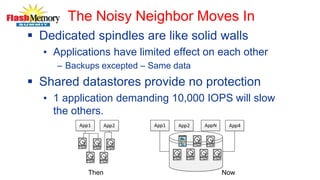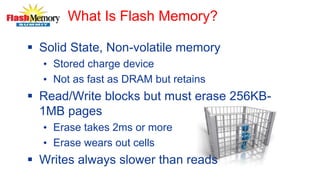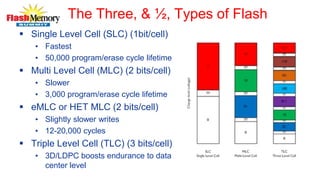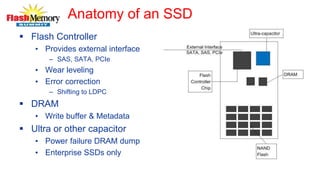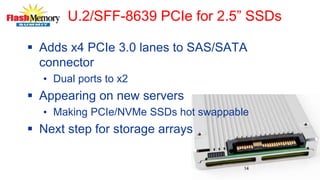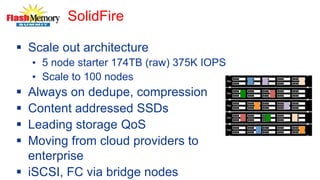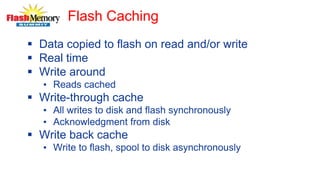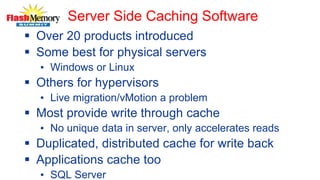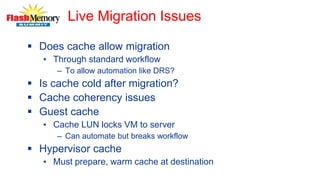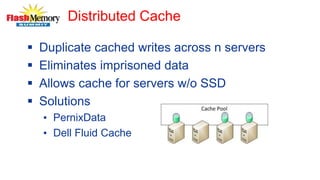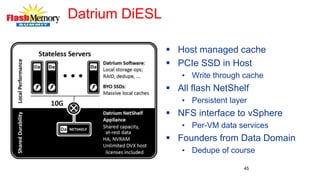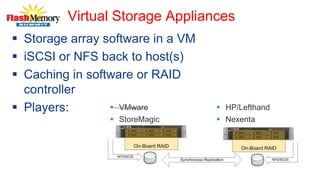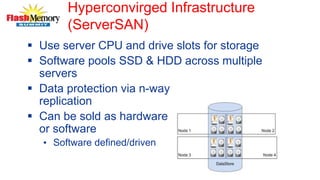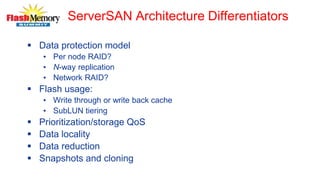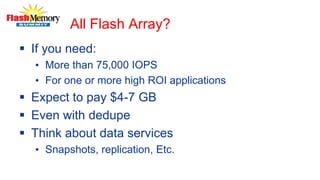2015 deploying flash in the data center
- 1. Deploying Flash in the Data Center Or How this Flash Makes Storage Like This Flash®
- 2. Today’s Agenda The storage performance problem Flash to the rescue • A brief flash memory primer • Flash/SSD types and form factors The All Flash Arrays (AFA) Hybrid arrays Server side flash Converged architectures Choosing a solution
- 3. The IO Gap Processor speed doubles every 2-3 years Disks have been stuck at 15K RPM since 2000
- 4. “The I/O Blender” Strains Storage Virtualization throws I/O into a blender… all I/O is now random I/O! 10 VMs doing sequential I/O to the same datastore=random I/O Disk drives are good at sequential, less good at random
- 5. The Noisy Neighbor Moves In Dedicated spindles are like solid walls • Applications have limited effect on each other – Backups excepted – Same data Shared datastores provide no protection • 1 application demanding 10,000 IOPS will slow the others. App1 App2 App1 App2 AppN App4 Then Now
- 6. VDI Presents Unique Workloads Highly variable but coincident (boot/login in AM) Steady state 50+% write 40+% of projects fail due to storage performance
- 7. Data Access Performance L1 processor cache ~1ns L2 processor cache ~4ns Main memory ~100ns PCIe SSD read 16-60μs (16,000-60,00ns) SAS/SATA SSD read 50-200μs (50,000- 200,000ns) Disk read 4-50ms (4-50,000,000ns) Moral of the story: keep IOPS away from the disk
- 8. Traditional Performance Solutions Head per track disk drives, DRAM SSDs • Huge price premium limits use to the very few Wide Striping • A 15K RPM disk delivers 200 IOPS • For 10,000 IOPS spread load across 50 drives – Of course that’s 15PB of capacity • Short stroking – Use just outside tracks to cut latency Wasting capacity wastes $ and OpEx (power, maint)
- 9. What Is Flash Memory? Solid State, Non-volatile memory • Stored charge device • Not as fast as DRAM but retains Read/Write blocks but must erase 256KB- 1MB pages • Erase takes 2ms or more • Erase wears out cells Writes always slower than reads
- 10. The Three, & ½, Types of Flash Single Level Cell (SLC) (1bit/cell) • Fastest • 50,000 program/erase cycle lifetime Multi Level Cell (MLC) (2 bits/cell) • Slower • 3,000 program/erase cycle lifetime eMLC or HET MLC (2 bits/cell) • Slightly slower writes • 12-20,000 cycles Triple Level Cell (TLC) (3 bits/cell) • 3D/LDPC boosts endurance to data center level
- 11. Flash’s Future Smaller cells are denser, cheaper, crappier • Today’s 1x nm cells (15-19nm) last planar node 3D is the future • Samsung now shipping 3D • Others sampling – SanDisk/Toshba 256GB/chip Other technologies post 2020 • PCM, Memristors, Spin Torque,
- 12. Anatomy of an SSD Flash Controller • Provides external interface – SAS, SATA, PCIe • Wear leveling • Error correction – Shifting to LDPC DRAM • Write buffer & Metadata Ultra or other capacitor • Power failure DRAM dump • Enterprise SSDs only
- 13. Flash/SSD Form Factors SATA 2.5” • The standard for laptops, good for servers SAS 2.5” • Dual ports for dual controller arrays PCIe • Lower latency, higher bandwidth • Blades require special form factors • M.2 for small form factors like notebooks • U.2 for 2.5” hot swap
- 14. U.2/SFF-8639 PCIe for 2.5” SSDs Adds x4 PCIe 3.0 lanes to SAS/SATA connector • Dual ports to x2 Appearing on new servers • Making PCIe/NVMe SSDs hot swappable Next step for storage arrays 14
- 15. Enter NVMe New logical interface for PCIe storage • Replaces ACHI More, deeper queues Simpler command set Lower latency • 300 vs 500+µs 15
- 16. SSDs use Flash but Flash≠SSD Fusion-IO cards • Atomic Writes – Send multiple writes (eg: parts of a database transaction) • Key-Value Store • FTL runs in host CPU
- 17. Diablo Puts Flash on the Memory Bus Memory Channel Flash (SanDisk UltraDIMM) • Block storage or direct memory • Write latency as low as 3µsec • Requires BIOS support Memory1 • 400GB/DIMM • No BIOS/OS Support • Volatile 17
- 18. Selecting SSDs Trust your OEM’s qualification • They really do test Most applications won’t need 100K IOPS Endurance ≠ reliability • SSDs more reliable than HDDs – 2 million hr MTBF – 10^17 BER vs 10^15 for near line HDD • Wear out is predictable • Consider treating SSDs as consumables • However don’t use read optimized drive in write heavy environment
- 19. SanDisk’s Enterprise SATA SSDs Name Sizes IOPS r/w Endurance Application Eco 240, 480, 960 80K/15K 1 DWPD, 3yr Read intensive Ascend 240, 480, 960 75K/14K 1 DWPD, 3yr Read intensive Ultra 200, 400, 800 75K/25K 3 DWPD, 5yr General purpose Extreme 100, 200, 400, 800 75K/25K 10 DWPD, 5yr Write intensive DWPD = Drive Writes Per Day
- 20. Consistent Performance is Key 20
- 21. Flash for Acceleration There are 31 flavors of flash usage What’s best for you depends on your: • Application mix • IOPS demand • Tolerance of variable performance • Pocketbook • Organizational politics
- 22. Basic Deployment Models SSDs in server as disk All solid state array Hybrid arrays • Sub LUN tiering • Caching Storage Network Caching Server side caching Hyperconverged infrastructures
- 23. Flash in the Server Minimizes latency and maximizes bandwidth • No SAN latency/congestion • Dedicated controller But servers are unreliable • Data on server SSD is captive • Good where applications are resilient – Web 2.0 – SQL Server Always On Software cross-server mirroring • But that adds latency to writes
- 24. All Flash Array Vendors Want You to Think of This
- 25. But Some Are This
- 26. Or Worse This
- 27. What You Really Want
- 28. Rackmount SSDs Our drag racers • They go fast but that’s all they do The first generation of solid state Not arrays because: • Single Controller • Limited to no data services • Thankfully dying out
- 29. The Hot Rods Legacy architectures with SSD replacing HDD • NetApp EF550 • EMC VNX-F • Equallogic PS6110s • Many 2nd and 3rd tier vendor’s AFAs Limited performance – 50-300,000 IOPS Full set of data management features Wrong architecture/data layout for flash
- 30. All Solid State Arrays Minimum dual controllers w/failover Even better scale-out Higher performance (1 megaIOP or better) Better scalability (100s of TB) Most have partial data management features • Snapshots, replication, thin provisioning, REST, Etc. May include data deduplication, compression • Lower cost w/minimal impact on performance
- 31. Legacy Vendors All Flash Array 3Par and Compellent’s data layout better for flash • Easier tiering, less write amplification Dell - Compellent • Mixed flash – SLC write cache/buffer, MLC main storage • Traditional dual controller HP 3Par Storeserv 7450 • 220TB (Raw) • 2-4 controllers
- 32. Pure Storage Flasharray//m Dual x86 Controllers in canisters 3u 300 KIOPS SAS shelves, U.2 ports in head PCIe NVRAM shared 2.75-35TB raw capacity Always on compress and dedupe FC, iSCSI or FCoE
- 33. SolidFire Scale out architecture • 5 node starter 174TB (raw) 375K IOPS • Scale to 100 nodes Always on dedupe, compression Content addressed SSDs Leading storage QoS Moving from cloud providers to enterprise iSCSI, FC via bridge nodes
- 34. EMC XtremIO Scale-out Fibre Channel X-Brick is 2 x86 servers w/SSDs Scales to 8 X-Bricks (but not online) Infiniband RDMA interconnect Shared memory requires UPS Full time dedupe, CAS 10-80TB raw
- 35. Violin Adds Services Violin was market leader in hotrod era That’s not enough Windows Flash Array - WSS on 6000 array Concerto 7000 storage routers ala Whiptail • Snapshots, replication Etc. via Falconstor • Scale to 280TB Unique flash modules • PCIe switched • Better consistency10/6/2015
- 36. Hybrid Arrays Combine flash and spinning disk in one system • Usually 7200RPM Legacy designs with SSDs added Next-Gen Hybrids – Tegile - Nimble – NexGen - Tintri High performance • 20,000 IOPS or more from 3-4u • 10% flash usually provides 2-4x performance boost Typically include deduplication, compression, virtualization features
- 37. Sub-LUN Tiering Moves “hot” data from slow to fast storage Only 1 copy of data Must collect access frequency metadata Usually on legacy arrays Ask about granularity, frequency • Up to 1GB, once a day Can give unpredictable performance
- 38. Flash Caching Data copied to flash on read and/or write Real time Write around • Reads cached Write-through cache • All writes to disk and flash synchronously • Acknowledgment from disk Write back cache • Write to flash, spool to disk asynchronously
- 39. Server Flash Caching Advantages Take advantage of lower latency • Especially w/PCIe flash card/SSD Data written to back end array • So not captive in failure scenario Works with any array • Or DAS for that matter Allows focused use of flash • Put your dollars just where needed • Match SSD performance to application • Politics: Server team not storage team solution
- 40. Caching Boosts Performance! 0 500 1000 1500 2000 2500 3000 3500 Baseline PCIe SSD Cache Low end SSD Cache Published TPC-C results
- 41. Write Through and Write Back 0 10000 20000 30000 40000 50000 60000 Baseline Write Through Write Back TPC-C IOPS • 100 GB cache • Dataset 330GB grows to 450GB over 3 hour test
- 42. Server Side Caching Software Over 20 products introduced Some best for physical servers • Windows or Linux Others for hypervisors • Live migration/vMotion a problem Most provide write through cache • No unique data in server, only accelerates reads Duplicated, distributed cache for write back Applications cache too • SQL Server
- 43. Live Migration Issues Does cache allow migration • Through standard workflow – To allow automation like DRS? Is cache cold after migration? Cache coherency issues Guest cache • Cache LUN locks VM to server – Can automate but breaks workflow Hypervisor cache • Must prepare, warm cache at destination
- 44. Distributed Cache Duplicate cached writes across n servers Eliminates imprisoned data Allows cache for servers w/o SSD Solutions • PernixData • Dell Fluid Cache
- 45. Datrium DiESL Host managed cache PCIe SSD in Host • Write through cache All flash NetShelf • Persistent layer NFS interface to vSphere • Per-VM data services Founders from Data Domain • Dedupe of course 45
- 46. Virtual Storage Appliances Storage array software in a VM iSCSI or NFS back to host(s) Caching in software or RAID controller Players: VMware StoreMagic HP/Lefthand Nexenta
- 47. Hyperconvirged Infrastructure (ServerSAN) Use server CPU and drive slots for storage Software pools SSD & HDD across multiple servers Data protection via n-way replication Can be sold as hardware or software • Software defined/driven
- 48. ServerSAN Products VMware’s VSAN • Scales from 4-32 nodes • 1 SSD, 1 HDD required per node Maxta Storage Platform • Data optimization (compress, dedupe) • Metadata based snapshots EMC ScaleIO • Scales to 100s of nodes • Hypervisor agnostic Atlantis Computing ILIO USX • Uses RAM and/or Flash for acceleration • Works with shared or local storage
- 49. ServerSAN Architecture Differentiators Data protection model • Per node RAID? • N-way replication • Network RAID? Flash usage: • Write through or write back cache • SubLUN tiering Prioritization/storage QoS Data locality Data reduction Snapshots and cloning
- 50. Hyper-converged Systems Nutanix • Derived from Google File System • 4 nodes/block • Multi-hypervisor • Storage for cluster only Simplivity • Dedupe and backup to the cloud • Storage available to other servers • 2u Servers No 20 other vendors incl. VMware’s EVO:RAIL
- 51. Questionable Idea 1: Smart Shelves How rack mount SSDs become arrays Adds data services/scale out in storage router Players: • Cisco Whiptail • Violin • XIO Storage Appliance Storage Router Storage Router Storage Appliance HP ProLiant DL380 G6 FANS PROC 1 PROC 2 POWER SUPPLY 2 POWER SUPPLY 1 OVER TEMP POWER CAP 1 2 3 4 9 8 7 6 5 4 3 2 1 1 2 3 4 5 6 7 8 9 ONLINE SPARE MIRROR UID 2 1 4 3 6 5 8 7 6 5 4 3 2 1 HP ProLiant DL380 G6 FANS PROC 1 PROC 2 POWER SUPPLY 2 POWER SUPPLY 1 OVER TEMP POWER CAP 1 2 3 4 9 8 7 6 5 4 3 2 1 1 2 3 4 5 6 7 8 9 ONLINE SPARE MIRROR UID 2 1 4 3 6 5 8 7 6 5 4 3 2 1 HP ProLiant DL380 G6 FANS PROC 1 PROC 2 POWER SUPPLY 2 POWER SUPPLY 1 OVER TEMP POWER CAP 1 2 3 4 9 8 7 6 5 4 3 2 1 1 2 3 4 5 6 7 8 9 ONLINE SPARE MIRROR UID 2 1 4 3 6 5 8 7 6 5 4 3 2 1 Storage Appliance Storage Appliance Workloads
- 52. Questionable Idea #2: Storage Network Caching “bump in the wire” cache Several vendors offered Fibre Channel versions • All discontinued NAS versions • Flopped in general market • Work as cloud gateways – Avere • HPC – DDN 5210/6/2015 Workloads Storage Caching Appliance(s)
- 53. All Flash Array? If you need: • More than 75,000 IOPS • For one or more high ROI applications Expect to pay $4-7 GB Even with dedupe Think about data services • Snapshots, replication, Etc.
- 54. Hybrids Hybrids fit most users • High performance to flash, capacity from disk • All automatic Look for flash-first architectures • Usually but not always from newer vendors Ask about granularity and frequency for tiering Again data services • Snaps on HDD • Per-VM services
- 55. I’ll give up Fibre Channel, When you pry it from my cold dead hands
- 56. Server Side Caching Decouples performance from capacity Strategic use • Pernix data write back cache w/low cost array Tactical solution • Offload existing array • Boost performance with minimal Opex
- 57. Questions and Contact Contact info: • [email protected] • @DeepStoragenet on Twitter
Editor's Notes
- #25: Lamborghini Gallardo 0-60 3.8 Top Speed 202
- #28: M5 0-60 3.7 Top Speed 205
- #38: Like driving by looking in rear view mirror EMC FAST VP algorithm: Each IO to slice adds to counter. Ios age out so after 24 hrs it’s worth .5 and after 7 days almost 0. Once an hour data is analyzed and slices sorted by “heat”. Data moved during allowed movement times (no more frequewntly than once/hr leaving 10% of fastest pool free for future promotions and new allocations to high proirity LUNS in pool. Schedule set for start time (IE 22:00 all 7 days), duration, UI shows estimated migration time. Uiser can select rate from high, med, low.
- #41: SQL Server/FlashSoft http://www.sandisk.com/assets/docs/SQL_Server_Performance_Enhancement.pdf
- #42: Note: Flashsoft data w/Virident SSD Baseline 15 15K RPM SAS disks RAID 0





